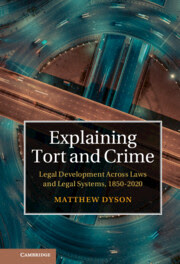ABOUT THE BOOK
Tracing almost 200 years of history, Explaining Tort and Crime explains the development of tort law and criminal law in England compared with other legal systems. Referencing legal systems from around the globe, it uses innovative comparative and historical methods to identify patterns of legal development, to investigate the English law of fault doctrine across tort and crime, and to chart and explain three procedural interfaces: criminal powers to compensate, timing rules to control parallel actions, and convictions as evidence in later civil cases. Matthew Dyson draws on decades of research to offer an analysis of the field, examining patterns of legal development, visible as motifs in the law of many legal systems.
The book completes a trilogy of works, along with the edited collections Unravelling Tort and Crime (2014), focused on English law, and Comparing Tort and Crime (2015), focused on modern comparative law, all published with Cambridge University Press.
ABOUT THE AUTHOR
Matthew Dyson is Professor of Civil and Criminal Law at the University of Oxford.
TABLE OF CONTENTS
Table of Contents Part I. Setting the Scene: Introduction and Methods for Explaining: 1. Introduction 2. Organising tort and crime Part II. Mental States and Careless Acts: The Development of Fault Doctrine in Crime and Tort: 3. Fault doctrines in criminal law 4. Fault doctrines in tort law 5. Explaining the criminal and tortious developments in fault doctrine Part III. Procedures Interfacing Tort and Crime: 6. Claims and formats 7. Timing rules 8. Criminal judgments in the civil law Part IV. Conclusions: 9. Patterns of development 10. Conclusions.


No comments:
Post a Comment